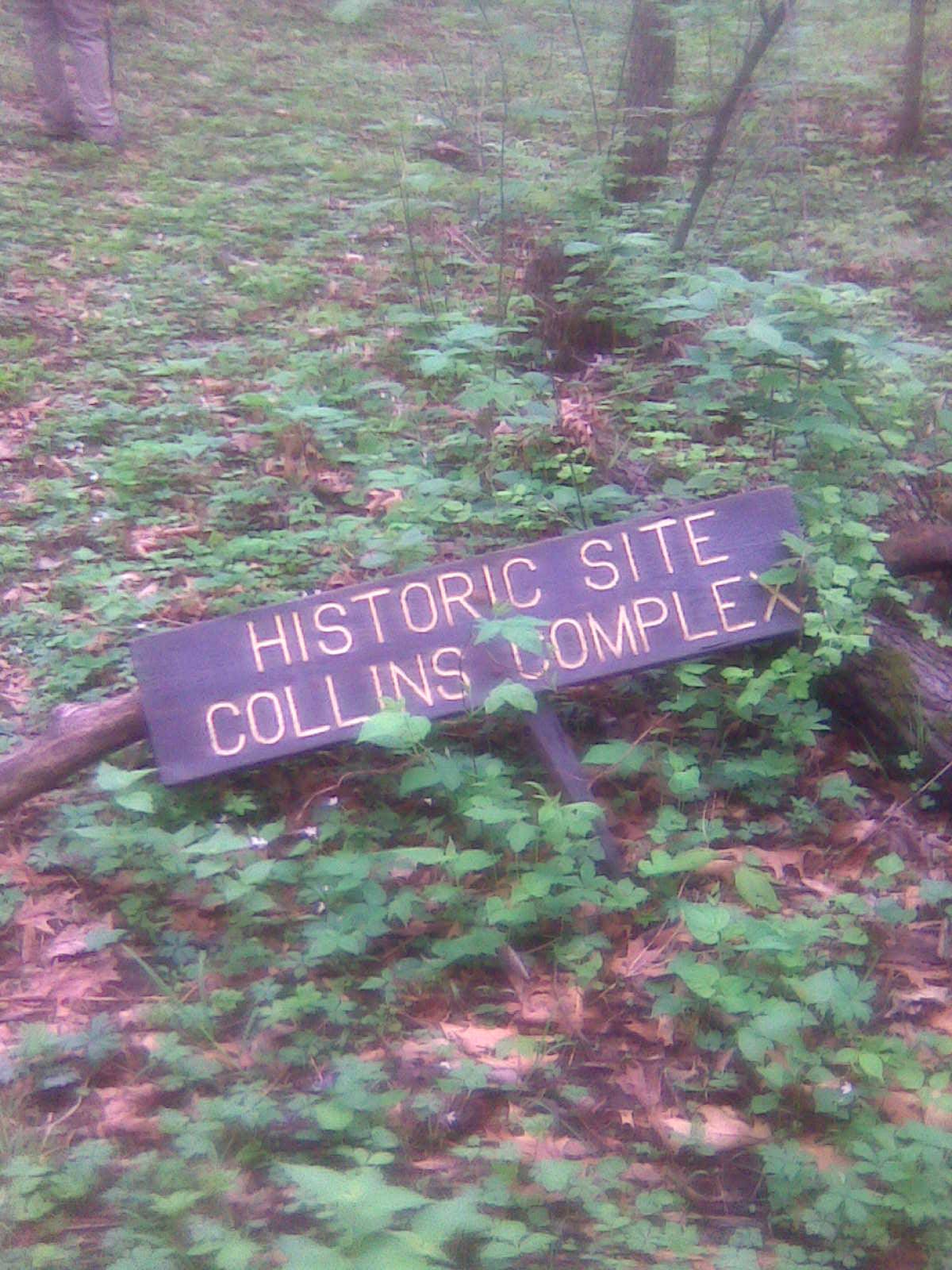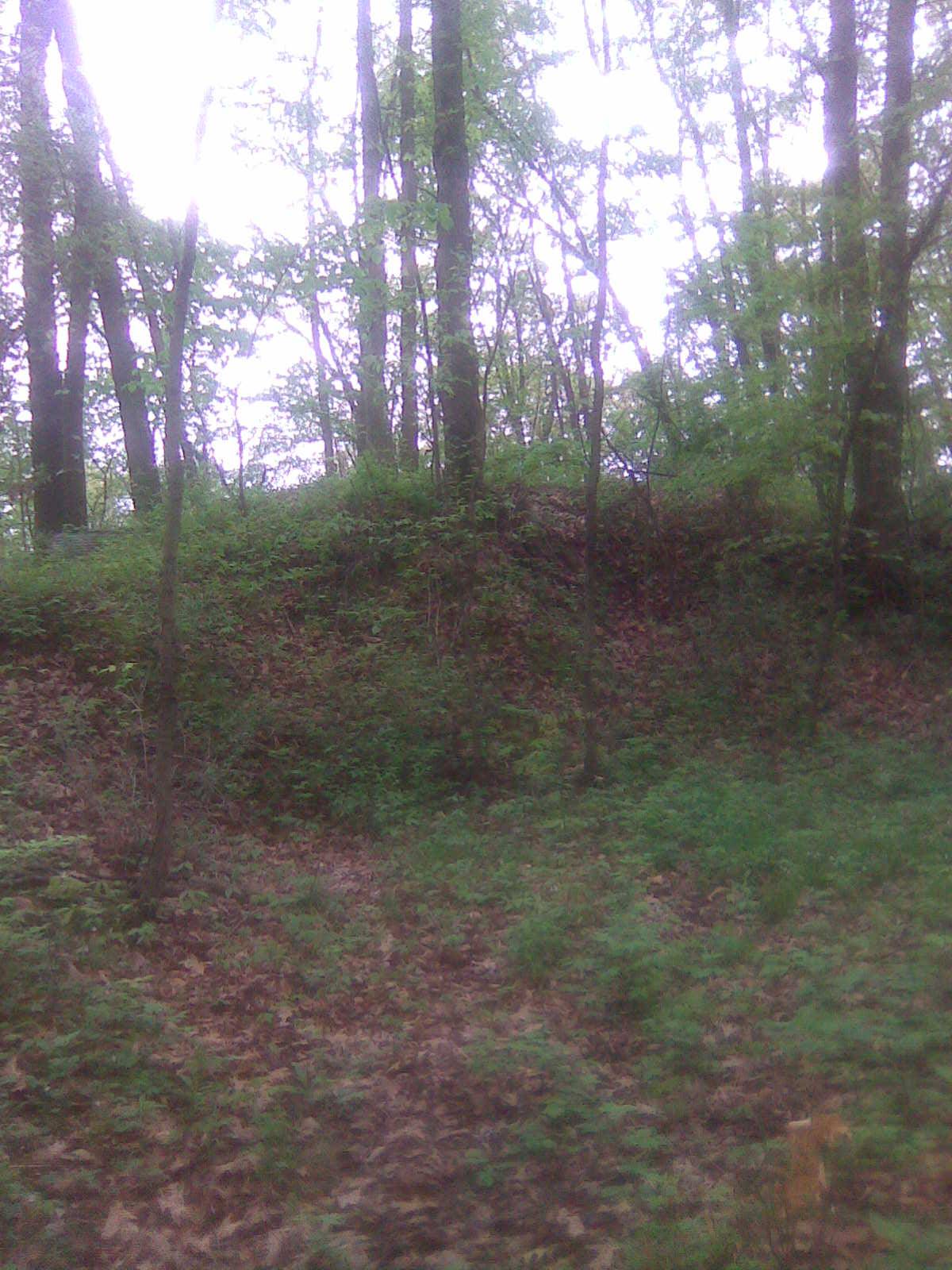 Indian Springs Mound is located northwest of Danville, Illinois along the Middle Fork of the Vermillion River, within Kennekuk County Park. The approximately seven-foot-tall prehistoric mound is significant because of its size (mounds from this time period in East Central Illinois tend to be smaller) and because it represents a connection between the people who created it and the Mississippian civilization of the same time period who built the city of Cahokia near East St. Louis, Illinois. Indian Springs Mound is part of the Collins Archaeological Complex inside the park. The complex consists of a village site area and five mounds.
Indian Springs Mound is located northwest of Danville, Illinois along the Middle Fork of the Vermillion River, within Kennekuk County Park. The approximately seven-foot-tall prehistoric mound is significant because of its size (mounds from this time period in East Central Illinois tend to be smaller) and because it represents a connection between the people who created it and the Mississippian civilization of the same time period who built the city of Cahokia near East St. Louis, Illinois. Indian Springs Mound is part of the Collins Archaeological Complex inside the park. The complex consists of a village site area and five mounds.
The people
Indian Springs Mound was built sometime between AD 1000 and 1100, near the end of a segment of prehistoric time that is referred to by archaeologists as the Late Woodland period. The Late Woodland era brackets the period from about AD 400 to about AD 1200. Native peoples who lived during the Late Woodland period led a lifestyle well adapted to the climate and vegetation conditions of the Midwest and elsewhere in the eastern United States. Important innovations that occurred during the Late Woodland period include the bow and arrow (circa AD 600) and the intensification of corn agriculture that occurred late in the period.
The Collins site inhabitants abandoned the site and the Middle Fork Valley for parts unknown well before Europeans arrived in Illinois. It is not known exactly why they moved on. Theories include resource depletion and/or forced migration because of warfare.
Doug Jackson, a University of Illinois archaeologist and an expert on the Collins site, said recently, “These people were likely gone by 1200 AD. We have no other evidence of people occupying the area until much later in the 1700s, when Kickapoo and Potawatomie groups were in the area; this is a pattern that occurs across much of the Midwest, where groups were abandoning areas that had been occupied, at least with small populations, throughout the Late Woodland period.”
Late Woodland people, including those at the Collins site, lived through a combination of agriculture and hunting and gathering. They farmed corn, squash, sunflower, numerous small seed-producing plants and numerous other plants. For these people, the toughest part of the year was the early spring, after winter food stores had been exhausted, but before spring and fall plants and crops were available.
However tough life may have been, Late Woodland people, including those at the Collins site, would have had some spare time during certain parts of the year and didn’t have to concentrate all of their energies strictly on surviving, one piece of evidence of this being that they farmed tobacco, a non-essential crop. Women in these groups did most of the cultivation and gathering, while men were more into hunting and warfare.
The Collins Complex occupants site were similar to other Late Woodland groups present along the major drainages of East Central Illinois, such as the Sangamon, Kaskaskia, and Embarras, and across wide areas of Central Indiana. All these groups may have spoken the same, or at least a similar language, but they did not have a system of writing.
In the absence of written records, much of what is known about these Late Woodland people comes through the pottery they left behind. By looking at what types of pottery have been found at what sites, for instance, archeologists can reach conclusions about trading patterns and group identities. Pottery was an evolving craft during the Late Woodland period. Containers were made of coils of clay mixed with substances such as crushed-up rock or bits of broken pottery. Once fired, the containers could be used as cooking or storage vessels.
Jackson explained, “Archeologists love pottery because it’s something that changes fairly quickly through time and then we identify time periods through pottery. It’s the best thing we have. We don’t have any surviving wood tools, the baskets they used; anything like that just doesn’t persist in the Midwest because of the climate and preservation conditions. They only started using pottery in the Midwest from about 800 BC on. Before that they were using leather bags, baskets, wooden containers…”
 The site
The site
Indian Springs mound is on a bluff overlooking the Middle Fork River (a branch of the Vermilion) and the Collins site itself. That Indian Springs Mound is located at this spot is not surprising. Jackson said of remnants of this time period, “It’s common to find sites such as this situated on high ground close to a river.”
The people who built Indian Springs Mound probably lived on the river bottom.
By the 1800s, Vermilion County was being settled and farmed by European settlers. The bluff of the Middle Fork River that Indian Springs Mound is on was probably largely cleared of trees by 1900, but was never farmed. Rather, it was used for grazing. A few very large trees along the bluff edge are likely remnants of the original forest and could be several hundred years old.
Eventually, the land was purchased by the government in the 1970s when there were plans to dam the river and create a reservoir. That project was ultimately cancelled and the land was transferred to the Vermillion County Conservation District and the forest vegetation returned.
The Collins site and related nearby sites began to be excavated by UI archaeologists in the 1970s when the sites were threatened by the reservoir project. A graduate student named John Goodwin Douglas excavated Indian Springs Mound itself and published his findings in his 1976 Ph.D. dissertation “Collins: A Late Woodland Ceremonial Complex in the Woodfordian Northeast”. Several years later, Dr. Thomas Riley conducted additional mound and village site excavations.
Today, the site is part of Kennekuk County Park. The UI, the East Central Illinois Archaeology Society, and the Illinois State Archaeological Survey, are all active in maintaining trails in the area, providing park administrators with site information, and studying what the people who built Indian Springs Mound and other sites left behind.
The ceremony
The precise site of Indian Springs Mound was chosen by its creators for a very specific reason: according to the work of John Douglas (the graduate student who excavated the site in the early 70s), it aligns with another mound at the Collins site on the river bottom and the rising sun at the winter solstice.
The Collins site mound that Indian Springs Mound aligns with is a flat-topped “platform” mound probably used as some kind of a ceremonial center. Platform mounds functioned primarily as locations for special purpose structures, such as ceremonial/ritual structures or the residences of the leaders.
According to Jackson, it’s “anybody’s guess” how many people worked on Indian Springs Mound. Different types of soil were hauled to the mound, which eventually measured about 90 x 70 x 7 ft. Why different soil types were used is not known, but there was probably some religious significance involved; builders hauled soil types dug from locations at longer distances from the mound than soils that were closer, even though the closer soils would have worked just as well for strictly practical reasons.
According to Jackson, the builders would have used tools such as digging sticks, antler tools and mussel shells to dig up the dirt used for the mound. He said, “They may have had a few stone hoes, but we have only limited evidence of them.”
At an unknown length of time following the construction of the initial platform mound, a crematory structure made of red cedar logs was built along the east side the mound. Then, the bodies of at least five individuals were placed on a scaffold inside the structure. Next, the crematory structure was set on fire. While this fire was still burning, the crematory structure area as well as the platform mound area were “capped” by piling clay dirt on top of the whole area, forming a larger, higher mound.
John Douglas uncovered evidence in his excavation including the charred timbers from the structure, the remnant remains of the five people placed within the structure, and the differences in the soil types used in the mound construction. He also documented the entire sequence of events of the ceremony.
The significance of this particular burial mound
During the time the people who built Indian Springs Mound were living at Collins site, a much larger and socially complex group of people existed to the southwest—the Mississippian culture. The largest city of this group of people was Cahokia, near East St. Louis. At its peak between AD 1100 and 1200, Cahokia had a population that researchers estimate at around 15-20,000. At the center of Cahokia is a massive platform mound called Monks Mound, which represents the largest mound north of Mexico (about 100 feet tall and covering 15 acres). Its base is about the same size as the base of the Great Pyramid of Giza in Egypt—quite a bit bigger than Indian Springs Mound, to say the least.
The Mississippian civilization was highly advanced and included people from all over the Central Mississippi valley. Its influence spread as far north as Wisconsin and as far West as Kansas City and throughout the south and southeast.
Evidence of interactions with Mississippians at the Collins Archaeological Complex is based on the presence of a small amount of Cahokia Mississippian-style pottery, and the fact that platform mounds (a Mississippian trait) were in use within the complex. Burying illustrious people in elaborate mounds was a Mississippian custom, and the five people associated with the Indian Springs mound were probably important members of their community as well. The burning event and the capping of this mound were probably done to honor these individuals.
Similar “mound-capping” events have been documented for several of the mounds at Cahokia
While tiny by Mississippian standards, Indian Springs Mound is actually one of the largest Native American burial mounds discovered by modern people so far in East Central Illinois. For example, the other burial mounds found in Kennekuk County Park are only around two feet tall. Weathered over the centuries and covered by plant life, it’s hard to even notice them unless they’re pointed out.








